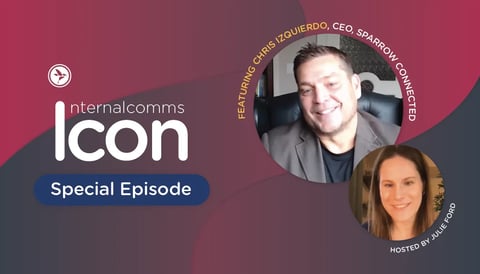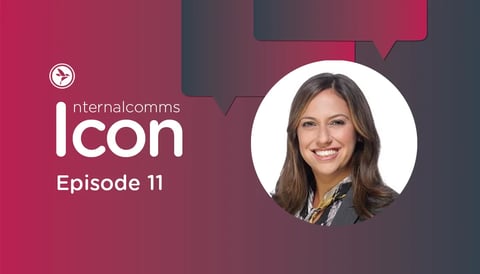Julie Ford 4:04
Thanks, Sara. That was really insightful. I've heard again and again from our podcast guests about the need to focus on solving business problems. And you also mentioned the concept of becoming a trusted advisor. Can you explain what is involved in becoming a trusted advisor and how internal communications professionals could do that successfully?
Sarah Robertson 4:24
I can talk about my experience, certainly, just being a trusted advisor, it's that it's that the ingredients of skill and chemistry and the internal communications leader needs to be really good at three things. So obviously highly skilled and experienced in developing executing, measuring communication strategy number two, emotionally intelligent and number three, proficient in overall corporate strategy and leadership. So here are my top fives on how to how to achieve that. At number one, learn the business. whatever business you're in whatever business you're supporting, work in it, not beside it. And this means you have to cultivate your business acumen. I've done this by taking a shift in the packaging suite, attending the market research focus groups, reading the trade pubs, observing the ad boards, go to the sales training, do the roleplay go on the ride alongs buy copies of whatever books it is that they read when I was in the pharma industry. Looking here at buy shelf, I've got copies of the DSM five, the CPS, the Dorland medical dictionary, go to the warehouse, learn to read the p&l. And really importantly, put your hand up for cross functional operations projects, especially those that are about org design, or go to market strategy. So that's tip number one, learn the business. Tip number two is cultivate networks, you have to collect people, you have to understand what motivates them to learn to read what they don't say, you need to talk to people who are very unlike you both from an energy perspective and a skills perspective, because the more diverse the perspectives you gather, the more useful you are to the to the CEO. Thirdly, this can be a tough one, speak the truth. If you're giving your opinion, you have to call it your opinion. Tell them how you formed it if you're presenting a hard truth, which is actually the best kind for us. If you're presenting a hard truth back it up with multiple credible sources, because whether they know it or not, there's a reality gap between the C suite and their employees and you need to fill it for them. My next tip is build coalitions. The CEO does not want to hear about your turf wars with HR and marketing. They do not want to hear how legal will not let you write this or implement that. So for internal communications, HR and legal are particularly important allies. So show them that you stand on common ground, you actually share their role of protecting and building the reputation of the organization and its products of managing risk, and protecting the CEOs credibility and leadership. And then take the solutions you've built together to the C suite. Show them where you've already incorporated HR legal or marketing input and created the alignment makes their job easier, makes you more valuable. And here's my final tip. See the whole board. The West Wing is one of my favorite serials of all times for many reasons. Lots of brilliant acting for Martin Sheen, Rob Lowe, the late John Spencer, brilliant writing by Aaron Sorkin, one of my favorite episodes aired in season three, which was somewhere around 2008. It was called Hartsfield's landing. So in this show, the Chinese are threatening to turn war games in the Taiwan straight into an actual war. And Sam, who's the Deputy communications director, he is really frustrated with the president for some of the decisions he's made. And he decides to tell the President this well, the two of them are playing a chess game. And what happens is the President simply encourages him to look at the whole board see the whole board, that meaning to step away from the emotions, the emotional roller coaster to stop looking at individual pieces and decisions and circumstances and see the entire picture. And when Sam does this, he actually correctly figures out the President's strategy. So if you can harness that power, which is the power to listen, see the whole board, you're going to be able to call the play in sync with the CEO. And then not only will you be able to anticipate their needs, but you're actually going to be able to advise them on implications of steps and solutions. So aside from my love of Sam seaborne played by Rob Lowe, see, the whole board is probably my biggest tip out of those five
Julie Ford 9:26
excellent tips. So just to recap, Sarah's five tips for becoming a trusted adviser to the C suite are one, learn the business to cultivate networks, three speak truth and speak facts for build coalitions and five, see the whole board. One of the common threads through all of your tips, Sarah is you know, it sounds like what the C suite really cares about is impact and outcomes of internal comms, is that correct?
Sarah Robertson 9:53
Yep. I would say that is right. And I would maybe frame it this way. I will I was talking to a former colleague Josh Matheson recently and he said something that just really keeps sticking with me. And it was this, no CEO or company pays its employees to read internal communications. Now, with both of us coming from any internal communications world, when he first said it, I kind of did like, Huh. And then as I've thought about it more, I just realized how right he is CEOs, and companies pay employees to drive revenue, deliver profitability, achieve customer satisfaction, affect policy change, produce, invent, innovate. So, therefore, our internal communications have to be purposeful. And the purpose of every communication must be to generate an environment in which they can do these things well. And while it might be fun for us to applaud ourselves on beautiful creative or high production values, and excellent writing, I mean, I love words, I agonize over them. What really matters is whether or not our communications caused something good to happen for the organization. And I think there are lots of metrics and methodologies you can dive into that are highly valid and important. And really, the guy you should be reading on this topic is Mike Klein. But I'm gonna boil it down to some things that I think are fairly simple and fundamental. And that that's this, did our materials or events or efforts cause employees to say, I know what the company's priorities are, I believe in the company's direction. I know the company has a positive future, I see how my work creates that positive future. And I have the information I need to align my work and my team's work to the company goals. And arguably, then the ultimate question when we say, what are the top three things on your desk? Do they match the company's top three stated priorities?













